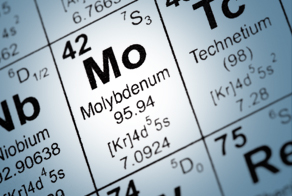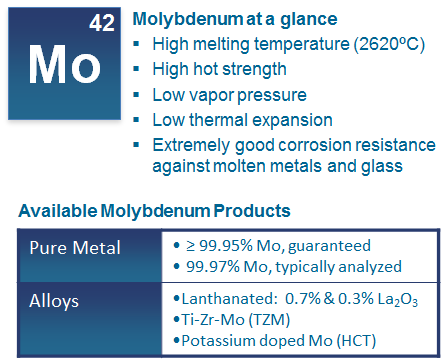Molybdenum and related alloys (TZM, MoLa, HCT)
Elmet Technologies is the leading North American manufacturer of pure molybdenum (Mo) metal. Our products are manufactured in the United States at our Lewiston, Maine facility. Elmet’s fully-integrated manufacturing starts with metal powder production through the reduction of molybdenum oxide to produce high purity Mo metal powder. We then utilize powder metallurgy processes to press and sinter ingots, then roll, swage, and draw the metal into fully-dense flat or round mill products. Rod, sheet, plate, foil, and wire mill products are either sold or used to feed our industry-leading fabrication and machining services. Fully integrated manufacturing enables Elmet to control and tailor material properties like ductility, tensile strength, hardness, grain size, and others to meet specific application requirements. Elmet maintains ISO9001 and AS9100 certified quality management systems.
Our Molybdenum products are available in following types:
- Molybdenum Powder
- Molybdenum Sheet
- Molybdenum Foil
- Molybdenum Plate
- Molybdenum Rod
- Molybdenum Wire
- Molybdenum Precision Machined Components
- Molybdenum Fabrications
Molybdenum Facts:
While well known for its high melting point, Mo and Mo alloys possess many additional properties that are useful in a number of applications:
- Symbol: Mo
- Category: Transition Metal, Group VI
- Atomic Number: 42
- Density: 10.28 g / cm3
- Discovered: 1778
- Molybdenum melting point, 2620 °C
- Load bearing capabilities at temperatures up to 1600 °C
- Excellent thermal and electrical conductivity
- Low vapor pressure at high temperature
- Low coefficient of thermal expansion
- Resistance to corrosion
- Shielding from high energy particles
High-Temperature Strength
Molybdenum properties are unique which makes it desirable for use in a number of manufacturing industries. For example, with its high melting point, 2620°C, molybdenum can work as a load bearing material in industrial furnaces at temperatures ranging 1600°C and up to 2000 °C for certain other applications. As the metal readily oxidizes above 400° C in air, a protective atmosphere like a vacuum, hydrogen-reducing, or inert gas is required for high-temperature operations. In addition to its high-temperature strength, molybdenum exhibits excellent thermal and electrical conductivity and low vapor pressure at elevated temperatures. Such properties, make molybdenum particularly useful metal injection molding, hot isostatic pressing, vacuum, nuclear fuel sintering, and glass melt furnaces.
Corrosion Resistance
Molybdenum’s resistance to corrosion makes it an ideal material for use in abrasive and aggressive environments. Examples include electrodes and flow control components for glass melt, semiconductor ion etching grid sets, MOCVD reactor components and assemblies, and hot runner nozzles used in plastic injection molding equipment.
Coefficient of Thermal Expansion
Molybdenum’s low coefficient of thermal expansion is an ideal property for a number of applications since as it heats up, it expands at a rate very close to common materials like glass and silicon. This property is very useful in lighting, flat panel display, and high-reliability electronics where Mo and the silicon or glass surfaces are bonded and thermally cycled.
Molybdenum Alloys
In addition to the pure metal, Elmet provides a number of molybdenum alloys suitable for higher temperatures and unique application requirements:
- Lanthanated molybdenum (MoLa)
- TZM (Titanium, Zirconium, Molybdenum): Increased strength at higher temperatures than pure Mo. In addition, TZM has a higher recrystallization temperature and improved creep resistance.
- HCT Molybdenum: HCT Molybdenum is used where retention of low-temperature ductility after exposure to high temperatures is required. HCT is particularly applicable to resistance heating elements, lamp filament supports, sintering trays, and electronic tube components. Recrystallized HCT molybdenum develops interlocked, elongated grain structures that remain relatively ductile at room temperature and below.
Please visit our resources page for more content and material information: Customer Resources


